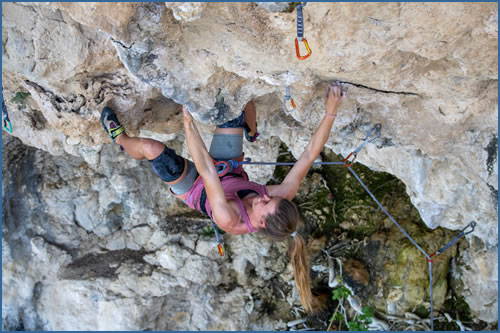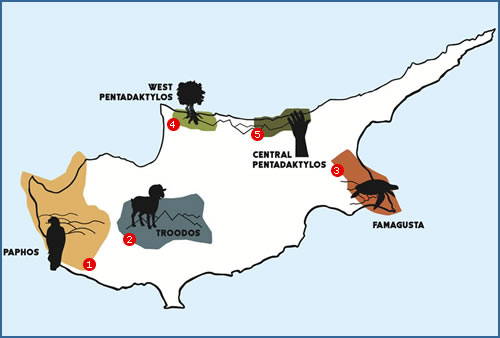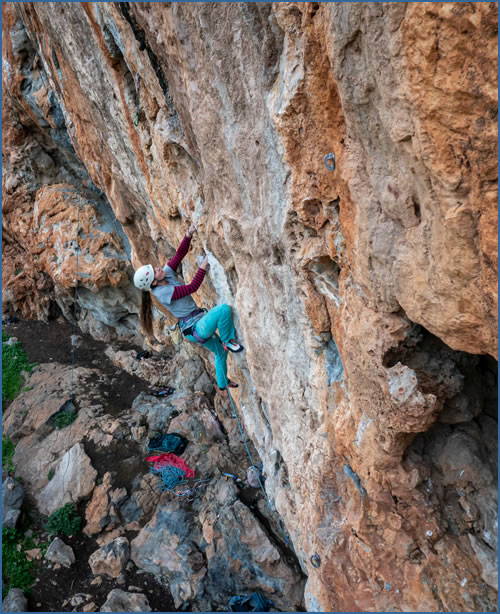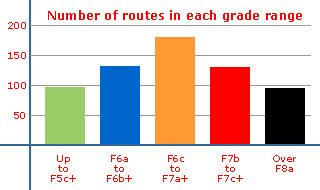Sport Climbing and Rock Climbing in Cyprus
Nestled in the azure waters of the Mediterranean, Cyprus boasts a stunning natural landscape with a diverse terrain, making it a popular destination for rock climbing. There are currently 5 main sport climbing areas in Cyprus with around 600 routes spread across 25 different crags.
Sport climbing in Cyprus offers a large variety of styles and grade ranges. There is everything from easy slabs and technical face climbing to steep, pumpy overhangs and tufa climbing. Crags range from secluded and unspoilt mountain areas to rugged coastal cliffs, and there are routes for everyone from the low F5’s to around F8b+/8c, with many projects still open.
All the information detailed below has been extracted from the Cyprus sport climbing guidebook that is available to buy from our shop.

Jenny Schauroth climbing Sfilikoutrin, F7c, at Goat House Crag in Northern Cyprus
1 – Paphos Area
The Paphos region is the largest climbing area in Cyprus with 7 established sport crags.
One of the most popular climbing spots in Paphos is locally known as Dhiarizos (Rock of Chasampoulion), an excellent compact limestone crag with almost 70 routes. The routes here span from F5a to F7c+ and offer mostly technical face climbing on vertical walls. The crag is orientated in such a way that it's always possible to find some shade, making it a good summer option! A river runs near the crag, providing a welcome place to cool off after a day's climbing.
Standing proud in the village of Episkopi is a steep and overhanging limestone rock that is home to some of the island’s hardest climbing. The crag is characterised by steep, powerful, and overhanging lines. The hardest route is currently 8b+, with harder projects still awaiting ascents.
To the west of Paphos, near the picturesque villages of Drouseia and Ineia are a cluster of sport crags. The main crag of the area is called Gerakopetra, but there are other crags scattered around with different styles and difficulties, including Konefti, Thermopiles and Drouseia. The climbing here is on compact sandstone, providing excellent friction and making for engaging routes that combine technical face climbing with tricky slab sequences. Routes here range from F5a to F8b+.
Map of the main sport climbing areas in Cyprus

| No | Crag | Total number of routes |
|---|---|---|
| 1 | Paphos | 244 |
| 2 | Troodos | 27 |
| 3 | Famagusta | 27 |
| 4 | West Pentadaktylos | 236 |
| 5 | Centra Pentadaktylos | 93 |
2 – Troodos Mountains
The Troodos Mountains are the highest point in Cyprus and offer remote, tranquil climbing particularly at Agios Nikolaos. Here there is a mixture of single pitch and multi-pitch routes, mainly in the F5 to F6’s grade range.
3 – Famagusta Area
Close to the popular tourist destination of Ayia Napa is the seaside crag of Cape Greco. The rock here is coarse, weathered limestone, perched above the azure waters of the Mediterranean. The climbing style is varied, including bulges, pockets, slabs and overhangs, with grades from F5’s to F7a. There is also an abundance of trad climbing here, much of which was developed in the late 1990s by the British RAF.
4 – West Pentadaktylos area
On the north part of Cyprus, in the Pentadaktylos mountain range, there is an abundance of crags to choose from. The western end of these mountains there are 12 limestone crags and is the second largest climbing area in Cyprus, with routes ranging from F5a to F8c, with unclimbed projects and more development potential awaiting.
Lapithou Main offers a selection of quality lines, including short and bouldery, long endurance routes and athletic tufa climbs. The Canyon has long, sustained technical climbs to test your endurance in a remote and peaceful setting. At Red Balcony, you’ll find powerful, athletic climbing on a cliff perched high above the valley. Tufa Ledge features climbs ranging from delicate and balancy to overhanging test pieces of a dynamic mix of slabs and tufas. At Ancient Wall, you can choose between technical, bouldery or power endurance. Nestled in the valley at Goat House, you can try hard on some of the hardest climbs on the island, through overhanging terrain, tufas and jugs.

Kim Lucas climbing the classic Mama Mia, F7b+, at Red Balcony Crag (Western Pentadaktylos area) in Northern Cyprus
5 – Central Pentadaktylos area
Garga Suyu was the first developed crag in the north part of the island. This crag offers varied and interesting climbing with good options at every level.
At Buffa Wall, you’ll find an impressive face wall with a unique and technical endurance style, home to one of Cyprus’ king lines, Buffa Jewel. Alev Kayasi is a sport crag with a mountainous feel with a selection of routes on slabs and vertical walls.
Cyprus Climbing Logistics and Beta
Cyprus rock climbing guidebook. The comprehensive guidebook for Cyprus is called the Cyprus Sport Climbing Guidebook that describes over 600 routes. In total there are 25 crags, with routes across a wide range of grades from low F5s to around F8b+/8c. 20% of all profits from this guidebook are allocated to the Cyprus Climbing Community Development Fund, which supports bolting, rebolting, crag maintenance, infrastructure projects and community events.
Cyprus Climbing season. The best time of year to sport climb in Cyprus is between November and April. It is possible to climb at other times of the year as some crags offer shade during the day, though it is recommended to avoid the hot, dry summer months.
Travel to Cyprus. The two main international airports are at Larnaca and Paphos. Flights to the north of the island are available to Ercan airport, however, these flights only operate to and from mainland Turkey.
Equipment required – Fifteen quickdraws and a 60m rope are sufficient for climbing throughout Cyprus. Only a few routes require additional quickdraws or a 70m rope.
